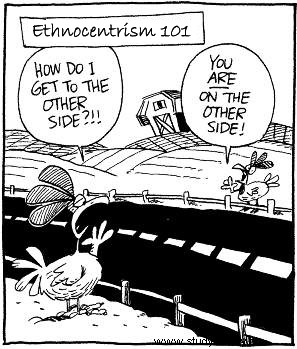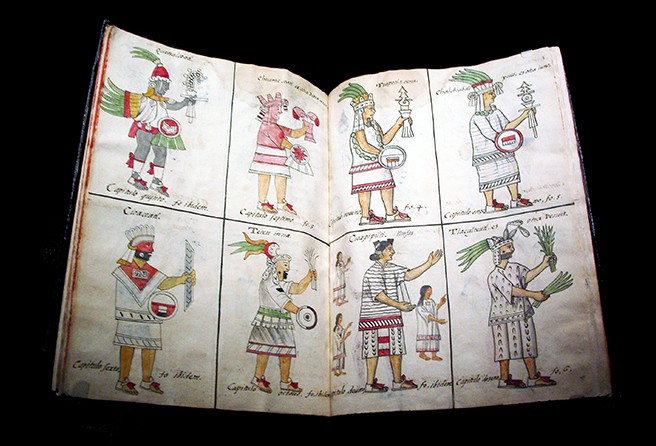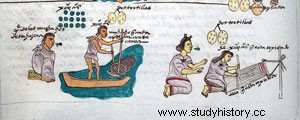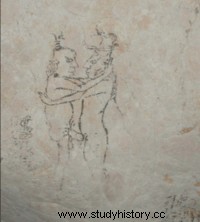Address cultural bias
The native two-spirits of North America showed identities in the pre-Columbian era that could be considered LGBT by today's standards. However, it is important when we talk about these identities that we do not add to our own cultural biases. Previous indigenous societies did not understand or perceive these identities in the same way as LGBT identities are today. The experiences of former people with these identities are similar to today's LGBT people, but not similar.

Bias in research
Many researchers do not take into account the flow of sexuality and gender. They see gender-segregated work divisions as hard barriers, rather than a proposal. The idealized or simplified depictions of life that are often studied are partly responsible for this bias. Iconography shows the social norms of the time, not the reality of life for the entire population. Creating a seamless narrative about practices and values that belong to the past is not a productive research path. Doing this will always leave out the contradictions and exceptions. There will always be variation in culture.
Two-Spirit Identity
Pre-Columbian period
Many Native American tribes recognize an identity called the two-spirit. People with this identity often have traits that are both feminine and masculine. The two-spirit identity was based on the work done for their community. For example, if a male person participated in tasks performed by women, they would be an individual with two spirits. These people often adopted their identity in childhood. If a child was uninterested in the task of women as a woman, they would be raised with male labor instead. In the Arctic, parents often chose to raise female children as two-spirited. This is because men wanted to hunt, and meat was the main source of food. If there were not enough male children, female children would take on the role of hunters. These women wanted to take on a masculine role and wear menswear.
Prestige
Two-minded people often had high status because of their identity. Two-spirit Navajo people were often dear healers or artists. Native societies viewed two-spirit individuals as very spiritually powerful. Two-minded people were often approached for spiritual matters, especially those involving young men and warriors. Some tribes in California entrusted two-spirit humans to bury the dead, since cisgender humans were not spiritually strong enough for such a task.
Early colonial times
When colonists first came to America, they documented cases of female-presenting individuals of the male sex and masculine-presenting individuals of the female sex. Feminine-presenting men would often have intimate relationships with men, while masculine-presenting women would have similar relationships with women. Colonists took great offense at this, and they were especially disturbed by the feminine-presenting male individuals. Colonists suppressed the identity of two-spirit people through forced conversion to Christianity. Tragically, Europeans also killed many two-minded individuals.
Consequences of colonization
The presence of masculine-presenting women and feminine-presenting men in Native American society declined drastically in the late 19th century. Forced assimilation caused negative attitudes towards homosexuality and "unconventional" gender expressions. The erasure of homosexuality and gender freedom in indigenous societies has led many natives to believe that these identities have no historical context.
Today
It is important to note that two-spirit is a modern term and would not have been used by former indigenous peoples. LGBT Indians coined the term to describe their experiences and relate them to the gender expression and homosexuality practiced by their communities before colonization. Native LGBT people looked to historical and anthropological evidence to rediscover the repressed identities of their ancestors. The concept of two-spirit makes many LGBT natives feel more connected to their indigenous roots. A Navajo person named Erna Pahe explains, “… we are Indians first, we are Navajo, we are Pima, we are Apaches. And we do not divide our group and say that we are gay and do differently. We are all Indians, and that's the way we express our feelings ... ".

Diné
The worldview of the Diné tribe is about flow and change. Their worldview has influenced them to have a loose, unlimited view of gender expression in the past. Today, however, the Diné tribe has a stricter view of sexuality. The Diné Marriage Act made same-sex marriage illegal in the Navajo nation. Those who oppose this action say that the decision was influenced by colonization and that indigenous peoples must reconnect with the faith of their past. There has also been pressure to educate students, especially those who are natives, on the history of bisexual people and the sexual flow of the past. This increase in education will hopefully reduce discrimination against two-minded individuals. Some natives believe that the identity of two spirits was created through colonial influence. Education will spread the word that this is not the case.
Aztec homosexuality
Spanish expedition writers wrote a document called the Florentine Codex in Spanish and Nahuatl. The purpose of the document was to describe the lives and society of those conquered before the king. This manuscript mentions homosexuality, but biased translations of the past skew the meaning. The passages that mention homosexuality contain difficult Nahuatl words whose meanings have not been preserved. The translators also allowed their cultural bias to influence the translation, using words such as sodomite and feminine. Geoffery Kimbal, author of "Aztec Homosexuality:The Textual Evidence", re-translated these passages in an attempt to remove the bias and correct the mistakes made due to not understanding aspects of the Nahuatl language.
attitudes
From the Florentine codex, it seems that the Aztec community did not view homosexuality in a positive light, especially homosexual men. However, Spanish influence over the text probably exaggerates this contempt. For example, the code describes the burning of gay men. It was the Spaniards who introduced this practice in the region. Attitudes towards gay women were not as negative. The Aztec community said that lesbians are more of a quirk and people to be wary of. The translation reads:"She is scandalous / something terrible / a warning." Although Aztec societies did not view homosexuality in a positive light, there is no evidence that they violently suppressed it before the arrival of the Spaniards.

Zapotec Muxe
Muxe are male individuals from the Zapotec culture who do not match men's gender expressions. Zapotec societies often accept muxe individuals, but do not accept female individuals who do not match female gender expression. People with this latter identity are called ngulu. Zapotec communities consider muxe individuals to be extremely intelligent and skilled. Zapotec culture considers the craft of muxe individuals to be more valuable than that of cisgender women. Muxe has the privilege of being able to pursue creative pursuits, which the Zapotec community values highly. Gay women do not have the same opportunity to work in the arts, which means they are less valued in the culture.
Discrimination
While discrimination against muxe individuals is not common in the Zapotec community, muxe must deal with harassment from non-indigenous peoples. Young muxe people can be discriminated against in their homes. There have been cases where families beat and shame their muxe child to test if they really are muxe. Families believe that the muxe individual will remain feminine even during such harsh treatment if they are truly muxe. Afterwards, the community will accept them. Many muxe people are proud to have undergone this treatment, as they see it as a confirmation of their identity.

Mesoamerica:An Overview
Iconography
Mesoamerican art depicting human bodies can provide insight into the gender expression of the time. Many human figures in these paintings show no primary or secondary gender characteristics. Depictions include scenes of elites performing rituals in clothing not usually worn by their sexes. This may symbolize a third gender or cross-dressing.
Division of labor
The traditional view of Mesoamerican divisions of labor sees women as involved in weaving, cooking, raising children, keeping animals, and performing house-related rituals. Men built homes, hunted, farmed, engaged in warfare, and were leaders. However, not all Mesoamerican individuals followed these roles. There is also evidence that these roles were not as rigorous as previously thought. For example, it is likely that people of all genders participated in the crucial task of agriculture. It is important to note that many Mesoamericans lived in small family units scattered throughout. One can not be picky about who completes tasks when the number of available people is limited.
Liquid
When a female individual held a leadership position in Mayan society, they often temporarily adopted a more masculine form of gender expression. This shows that the division of labor, and the gender expression itself, was quite fluid. Class and age shaped the way Mesoamericans experienced gender. The experiences of an elite woman and those of an ordinary woman are very different. For the Aztecs, the process of growing up was more important for the development of one's place in society.

Mayaene
The Maya used homosexual sex for their own gain. Elites wanted to perform rituals in which they raped the gods in order to exploit their power. The Mayan worldview linked penetration with war, human sacrifice and bloodshed through the penis. The Mayans defined sex as the act of penetration, regardless of which part of the body was penetrated. The moon goddess of Mayan mythology engaged in sexual acts with both men and women. The Mayans understood that she was both penetrated and penetrator in these cases, indicating her dual nature. An example of this comes from a ritual meant to shoot away spiders. In the ritual, the moon goddess has sex with a female spider. The spider has a penis, which emphasizes the masculine and feminine aspects of life.
Homosexuality in Central America today
Many Central American countries view homosexuality as shameful because of a history of misogyny. Men who are penetrated by other men are seen as submissive and weak. Fellowship often has more tolerance for men who are the penetrator, as this role is more in line with the role of a heterosexual man. Since women are not as valued as men in Latin society, the man who takes on the "role of women" in sexual activity is also less valued.

lesbians
Literature covering LGBT issues often excludes women. This often has to do with what qualifies as sex in different cultures. As mentioned in the Mayan section, they looked at sex acts involving penetration. This often does not occur with lesbian sex, which means that there is no "real" sexual activity in certain contexts. However, Native American research omits lesbians for another reason. This is because the gender identities of indigenous groups are less binary. Lesbianism can therefore not be defined as easily. Two-spirit women from the past entered into relationships with both men and women. On the contrary, research emphasizes two-spirit male relationships with men. This is the case even though it is common knowledge that two-spirit males also often had relationships with females. This shows Western bias, as the gay identity has received more attention (positive and negative) than the lesbian identity in European contexts.

Support for two-spirit populations
Native Americans of all identities have encountered problems accessing health care. Most of the efforts focused on health services for individuals with two spirits involve HIV and AIDS research. Although this is an important issue, the emphasis on HIV has led to stigma against individuals with two spirits and neglect of other health needs. Health services for two-minded people also lack a connection to society. Social ties are important for the health of everyone, especially marginalized groups. Native Americans in particular value their family ties, so it is important that two-minded individuals feel connected to their communities. Underrepresentation in demographic surveys is another problem. Data is needed to meet and meet the needs of society.

Concluding remarks:History is power
The historical significance of LGBT people in Central and North America is enormous. The identities of former people help members of current societies to find their place in society. The colonial powers tried to silence this story, and largely succeeded in shaping the attitudes Indigenous peoples adhere to LGBT identities today. The story is deeply personal, seen through the connection that two-spirited people feel today to those from the pre-colonial past. It is important for everyone to reflect on our story, as it can provide clarity in the face of confusion. Discussing history also prevents the recurrence of mistakes made by our ancestors, and allows for success where they failed. Providing adequate medical treatment for individuals with two spirits and Indians in general is one step of many needed to address the wrongs of the past and present.

